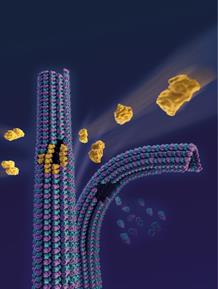The principal elements of the internal architecture of cells,
microtubules are more than one hundred times more rigid than the other components of the cytoskeleton. For this reason, they pass quasi-linearly through the intracellular space and thus serve as a transport path for proteins between the center and the periphery of the cell. As their mechanical properties could not be studied in detail for lack of an appropriate tool, researchers from the CEA, the CNRS and the Université Grenoble/Alpes developed a
microfluidic device that can attach and bend microtubules. They discovered that during the repeated stress cycles, the microtubules fold more and more but do not break. The application of external stresses makes them increasingly more flexible. Their
structure therefore seems
capable of reorganizing itself and adapting to the stresses. Even more surprisingly, the microtubules are capable of regaining their initial rigidity if the stresses are interrupted for several minutes, and are spontaneously repaired.

By using tubulin at different concentrations and colors, the researchers demonstrated that the quasi-crystalline structure of microtubules can contain defects, representing weakness points. It is from these points that the filaments disassemble under stress, making the microtubules more flexible. Conversely, during the rest phases, the filaments can incorporate new molecules of tubulin and thus repair the damaged structure, which then regains its original rigidity.
Model of dissociation and repair of the structure of microtubules under stress. © Agnieszka Kawska, Illuscientia
This innovative work is a first step towards a better understanding of how microtubules function. They are at the heart of regulating many cellular processes such as cell division or the activity of neurons. Far from the conventional view in which microtubules only come together at their extremities, it now appears that the self-assembly mechanisms of the filaments that form them offer a range of unsuspected mechanical and biochemical properties, whose contribution to multiple microtubule functions remains to be elucidated. Additionally, microtubules could provide a basis for designing new devices with applications as varied as textiles or the electronics of the future.